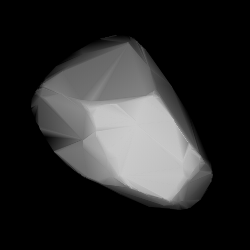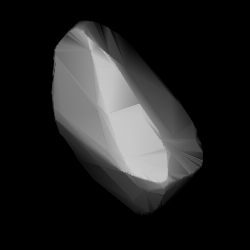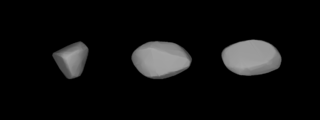Related Research Articles

Stephania is a dark background asteroid from the inner regions of the asteroid belt, approximately 32 km (20 mi) in diameter. It was discovered on 19 May 1881, by Austrian astronomer Johann Palisa at the Vienna Observatory. The C-type asteroid has a rotation period of 18.2 hours. It was named after Princess Stéphanie of Belgium.
716 Berkeley is a background asteroid from the central regions of the asteroid belt. It was discovered by Austrian astronomer Johann Palisa at the Vienna Observatory on 30 July 1911. The stony S-type asteroid has a rotation period of 15.6 hours and measures approximately 21 kilometers in diameter. It was named after the city of Berkeley, California, where the discoverer's colleague Armin Otto Leuschner (1868–1953) was the director of the local observatory.

722 Frieda is a bright background asteroid and slow rotator from the inner regions of the asteroid belt. It was discovered by Austrian astronomer Johann Palisa at the Vienna Observatory on 18 October 1911. The stony S-type asteroid has a notably long rotation period of 131.1 hours and measures approximately 9 kilometers in diameter. It was named after Frieda Hillebrand, daughter of Austrian astronomer Karl Hillebrand (1861–1939), and grand-daughter of Edmund Weiss (1837–1917) who had been the director of the discovering observatory.

868 Lova is a large and dark background asteroid, approximately 51 kilometers in diameter, from the central regions of the asteroid belt. It was discovered by German astronomer Max Wolf at the Heidelberg-Königstuhl State Observatory on 26 April 1917. The carbonaceous C-type asteroid (Ch) and has a long rotation period of 41.1 hours and is likely elongated in shape. The origin of the asteroid's name remains unknown.
971 Alsatia, provisional designation 1921 LF, is a carbonaceous background asteroid from the central region of the asteroid belt, approximately 60 kilometers in diameter. It was discovered on 23 November 1921, by French astronomer Alexandre Schaumasse at Nice Observatory in southeastern France. The asteroid was named after the French province Alsace.

984 Gretia is a stony background asteroid from the central regions of the asteroid belt, approximately 32 kilometers in diameter. It was discovered by German astronomer Karl Reinmuth at the Heidelberg-Königstuhl State Observatory on 27 August 1922 and given the provisional designation 1922 MH. The asteroid was named after Greta, sister-in-law of ARI-astronomer Albrecht Kahrstedt.

1039 Sonneberga, provisional designation 1924 TL, is a dark background asteroid, approximately 34 kilometers in diameter, located in the central region of the asteroid belt. It was discovered on 24 November 1924, by German astronomer Max Wolf at Heidelberg Observatory in southwest Germany. The asteroid was named for the German city of Sonneberg, where the Sonneberg Observatory is located.

1214 Richilde, provisional designation 1932 AA, is a dark background asteroid from the central regions of the asteroid belt, approximately 35 kilometers in diameter. It was discovered by Max Wolf at Heidelberg Observatory in 1932. Any reference of the asteroid's name to a person is unknown.
1049 Gotho, provisional designation 1925 RB, is a carbonaceous asteroid from the outer region of the asteroid belt, approximately 53 kilometers in diameter. It was discovered on 14 September 1925, by German astronomer Karl Reinmuth at Heidelberg Observatory in southwest Germany. Although the name of the asteroid is a masculine German name, it is not known to refer to a particular individual.

1095 Tulipa is an Eos asteroid from the outer regions of the asteroid belt. It was discovered by German astronomer Karl Reinmuth at the Heidelberg-Königstuhl State Observatory in southwest Germany on 14 April 1926. The assumed S-type asteroid has a rotation period of 2.8 hours and measures approximately 30 kilometers in diameter. It was named after the flower Tulip. Originally, the name was redundantly assigned to Florian asteroid 1449 Virtanen.

1119 Euboea is a background asteroid from the central region of the asteroid belt. It was discovered on 27 October 1927, by German astronomer Karl Reinmuth at the Heidelberg-Königstuhl State Observatory in southwest Germany. The asteroid has a rotation period of 11.4 hours and measures approximately 30 kilometers in diameter. It was named for the Greek island of Euboea.
1136 Mercedes, provisional designation 1929 UA, is a background asteroid from the central regions of the asteroid belt, approximately 26 kilometers in diameter. It was discovered on 30 October 1929, by Catalan astronomer Josep Comas i Solà at the Fabra Observatory in Barcelona, Spain. The asteroid was named for the sister-in-law of the discoverer.
1156 Kira, provisional designation 1928 DA, is a stony background asteroid from the inner regions of the asteroid belt, approximately 9 kilometers in diameter. It was discovered on 22 February 1928, by German astronomer Karl Reinmuth at Heidelberg Observatory in southwest Germany. Any reference of its name to a person or occurrence is unknown.
1163 Saga, provisional designation 1930 BA, is a background asteroid from the outer regions of the asteroid belt, approximately 32 kilometers in diameter. It was discovered on 20 January 1930, by astronomer Karl Reinmuth at the Heidelberg-Königstuhl State Observatory in southwest Germany. The asteroid was named after the Sagas, a collection of stories from Norse mythology.
1319 Disa, provisional designation 1934 FO, is a carbonaceous asteroid from the outer region of the asteroid belt, approximately 25 kilometers in diameter. It was discovered on 19 March 1934, by English-born, South African astronomer Cyril Jackson at Johannesburg Observatory in South Africa. It is named for the orchid Disa.

1248 Jugurtha is a stony background asteroid from the central regions of the asteroid belt, approximately 29 kilometers in diameter. Discovered by Cyril Jackson at the Union Observatory in 1932, the asteroid was named after Jugurtha, the ancient North African king of Numidia. The S-type asteroid is likely elongated in shape and has a rotation period of 12.9 hours.
1264 Letaba, provisional designation 1933 HG, is a carbonaceous asteroid and possible tumbler from the background population of the outer asteroid belt, approximately 70 kilometers in diameter. It was discovered on 21 April 1933, by South African astronomer Cyril Jackson at the Union Observatory in Johannesburg. The asteroid was named for the Letaba River in eastern South Africa.

1930 Lucifer, provisional designation 1964 UA, is a carbonaceous asteroid from the outer regions of the asteroid belt, approximately 34 kilometers in diameter. It was discovered on 29 October 1964, by American astronomer Elizabeth Roemer at the Flagstaff station (NOFS) of the United States Naval Observatory (USNO). It is named after Lucifer, the "shining one" or "light-bearer" from the Hebrew Bible.

1175 Margo, provisional designation 1930 UD, is a stony background asteroid from the outermost regions of the asteroid belt, approximately 24 kilometers in diameter. It was discovered on 17 October 1930, by astronomer Karl Reinmuth at the Heidelberg-Königstuhl State Observatory in southwest Germany. The meaning of the asteroids's name is unknown.
1305 Phongolo, provisional designation 1928 OC, is a background asteroid from the outer regions of the asteroid belt, approximately 25 kilometers in diameter. It was discovered on 19 July 1928, by English astronomer Harry Edwin Wood at the Union Observatory in Johannesburg, South Africa. The asteroid was named for the South African Pongola River.
References
- 1 2 3 4 5 6 "JPL Small-Body Database Browser: 1152 Pawona (1930 AD)" (2017-06-04 last obs.). Jet Propulsion Laboratory . Retrieved 8 September 2017.
- 1 2 3 Schmadel, Lutz D. (2007). "(1152) Pawona". Dictionary of Minor Planet Names – (1152) Pawona. Springer Berlin Heidelberg. p. 97. doi:10.1007/978-3-540-29925-7_1153. ISBN 978-3-540-00238-3.
- 1 2 3 4 5 6 7 "LCDB Data for (1152) Pawona". Asteroid Lightcurve Database (LCDB). Retrieved 8 September 2017.
- 1 2 3 4 Tedesco, E. F.; Noah, P. V.; Noah, M.; Price, S. D. (October 2004). "IRAS Minor Planet Survey V6.0". NASA Planetary Data System. 12: IRAS-A-FPA-3-RDR-IMPS-V6.0. Bibcode:2004PDSS...12.....T . Retrieved 22 October 2019.
- 1 2 3 4 Usui, Fumihiko; Kuroda, Daisuke; Müller, Thomas G.; Hasegawa, Sunao; Ishiguro, Masateru; Ootsubo, Takafumi; et al. (October 2011). "Asteroid Catalog Using Akari: AKARI/IRC Mid-Infrared Asteroid Survey". Publications of the Astronomical Society of Japan. 63 (5): 1117–1138. Bibcode:2011PASJ...63.1117U. doi:10.1093/pasj/63.5.1117. (online, AcuA catalog p. 153)
- 1 2 3 Masiero, Joseph R.; Grav, T.; Mainzer, A. K.; Nugent, C. R.; Bauer, J. M.; Stevenson, R.; et al. (August 2014). "Main-belt Asteroids with WISE/NEOWISE: Near-infrared Albedos". The Astrophysical Journal. 791 (2): 11. arXiv: 1406.6645 . Bibcode:2014ApJ...791..121M. doi:10.1088/0004-637X/791/2/121. S2CID 119293330 . Retrieved 8 September 2017.
- 1 2 3 4 Mainzer, A.; Grav, T.; Masiero, J.; Hand, E.; Bauer, J.; Tholen, D.; et al. (November 2011). "NEOWISE Studies of Spectrophotometrically Classified Asteroids: Preliminary Results". The Astrophysical Journal. 741 (2): 25. arXiv: 1109.6407 . Bibcode:2011ApJ...741...90M. doi:10.1088/0004-637X/741/2/90. S2CID 118700974.
- 1 2 3 Behrend, Raoul. "Asteroids and comets rotation curves – (1152) Pawona". Geneva Observatory . Retrieved 8 September 2017.
- 1 2 Schmidt, Richard E. (July 2017). "Near-IR Minor Planet Photometry from Burleith Observatory". The Minor Planet Bulletin. 44 (3): 191–192. Bibcode:2017MPBu...44..191S. ISSN 1052-8091 . Retrieved 8 September 2017.
- 1 2 Koff, R. A.; Clark, M. (September 2002). "Lightcurve Photometry of 1152 Pawona". The Minor Planet Bulletin. 29: 49–50. Bibcode:2002MPBu...29...49K . Retrieved 8 September 2017.
- 1 2 Klinglesmith, Daniel A. III; Hendrickx, Sebastian; Kimber, Cameron; Madden, Karl (July 2017). "CCD Asteroid Photometry from Etscorn Observatory". The Minor Planet Bulletin. 44 (3): 244–246. Bibcode:2017MPBu...44..244K. ISSN 1052-8091 . Retrieved 8 September 2017.
- ↑ Veres, Peter; Jedicke, Robert; Fitzsimmons, Alan; Denneau, Larry; Granvik, Mikael; Bolin, Bryce; et al. (November 2015). "Absolute magnitudes and slope parameters for 250,000 asteroids observed by Pan-STARRS PS1 - Preliminary results". Icarus. 261: 34–47. arXiv: 1506.00762 . Bibcode:2015Icar..261...34V. doi:10.1016/j.icarus.2015.08.007. S2CID 53493339 . Retrieved 8 September 2017.
- 1 2 3 4 "1152 Pawona (1930 AD)". Minor Planet Center. Retrieved 8 September 2017.
- ↑ Peebles, Curtis (2000). "The attack of the classicists". Asteroids: A History. Smithsonian Institution Press. ISBN 978-1-56098-982-0.